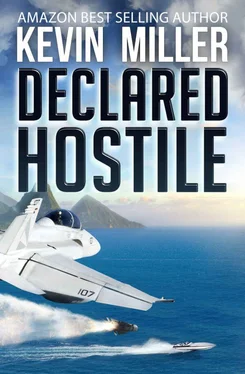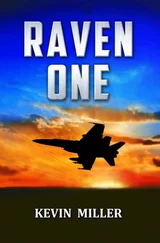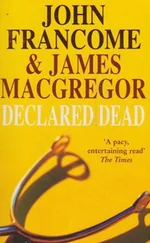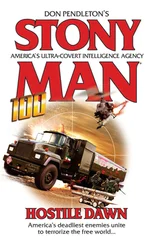Relieved, Wilson continued his checks. He soon noted an impatient yellow shirt director asking, via hand signals, if he was ready to taxi so they could begin to use Cat 2. With fifteen minutes to launch, Wilson knew he could finish his cockpit tasks elsewhere on deck — even airborne, if need be, heading to the tanker. The yellow shirt directed him to hold brakes as blue-shirted sailors ran underneath 301 to remove the tie-down chains. A moment later, the plane captain emerged with chains draped over his shoulders, giving his CO a salute that Wilson returned.
Wilson added a touch of power and crept forward as the yellow shirt directed him out of his spot and turned him aft down the bow. Twelve minutes to launch and the ship was still knifing south into the wind. A Hummer with folded wings and spinning props was parked behind the Cat 2 jet blast deflector. Wilson taxied past it, and the dozens of squadron troubleshooters, with care. The E-2s and tankers would be launched soon, and he needed to conduct a roll call on the strike common frequency.
“Ninety-nine Broadsword , radio check. Slash one-one.”
“ Slash one-two,” Dusty responded in turn.
“ Slash one-three,” DCAG transmitted.
“ Slash one-four,” Stretch continued in order.
The rest of the strike package checked in: the Blockers, Volts, Lances, Condors , and the Super Hornet mission tankers, call sign Arco . The flight deck was a jumble of aircraft as the yellow shirts lined them up behind the catapults, and Wilson could see the deck was doing a good job of shooting them according to plan. He and the others in each cockpit continued with their checks — or just waited, lost in their thoughts. Wilson glanced at Ghost next to him. The nugget pilot was on his first combat mission, and, to Wilson, he appreared confident.
On the horizon, Gettysburg knifed through the waves in escort, a wisp of spray flying over her bow. As the strikers joined up on the Air Force tankers, she would launch a volley of TLAM to soften up San Ramón before Wilson’s main battery arrived with the hammer.
Looking up at the island that towered above him, Wilson saw FOXTROT flapping hard in the breeze. Coral Sea’s large battle flag flew above it at full extension as radar antennas spun from nearby masts. Wilson and thousands of his shipmates were on a U.S. Navy aircraft carrier preparing to project national power — and will — against an enemy, as carriers had done for decades. But Venezuela? Even minutes from launch, Wilson was uneasy about what the United States was doing. Didn’t the diplomatic thing fade away? Does Venezuela really want a fight with us? Everything had happened so fast, and he was not sure the politicians in Washington knew what they were doing, launching a series of pin-prick raids that Venezuela could recover from within days. Like cutting a damn runway!
Wilson was also uneasy because this complex strike was not suitcased , the details not thoroughly understood by all the strikers, including him, the strike lead. Having a comfortable four out of five strike details covered, meant that an uncomfortable one out of five was not. This strike required answers to hundreds of such details. They would have to make it up as they went, and Wilson expected there would be a time tonight where he would have to audible: You do a buttonhook. You go long . Not a preferred recipe for success.
From his warm cocoon, Wilson saw the deck crew brace themselves against the wind. He noted the ship was turning to align the wind vane with the ship’s longitudinal axis. The early launch was now sending the Hawkeyes and Rhino tankers up to relieve some pressure off the crowded flight deck. Blockers were scheduled next, and Wilson saw they were spotted behind the jet blast deflectors to be hooked up and shot in short order into the gray sky.
Wilson happened to look up and catch the dark silhouette of a large aircraft with swept wings against the high overcast, heading south. Scanning the nearby sky, he saw another one a few miles in trail. He knew this must be the KC-10s, call sign Shell . Wilson was fascinated, never having seen mission tankers transiting to their station overhead the ship, and he was thankful for the real-time intelligence it provided him. Two tankers proceeding to station as planned. With their 400-knot ground speed, the tankers would arrive at their station before the carrier aircraft just getting airborne underneath them, but not by much. Sometimes things just worked out, and Wilson was relieved he didn’t have to sweat how many hoses would be available to his thirsty jets. He caught the attention of Stretch who was parked next to him, awaiting his turn at the catapult. Wilson pointed at the tankers high above them and received a vigorous thumbs-up in response. Wilson watched the tankers recede and wondered if the AWACS and EP-3 were also proceeding to their stations.
Deafening waves of deep resonating sound from afterburning engines at max power continued to bombard the flight deck crew as aircraft went into tension on both the bow and the waist, pilots cycling the controls before saluting their readiness to launch. Wilson watched the heavy aircraft, loaded down with missiles and bombs, claw their way into the air and accelerate ahead of Coral Sea as it rose and fell on the eight-foot seas. Wilson always felt awed by the sailors as they moved about the screaming aircraft with purpose, communicating to pilots and each other with hand signals as they went about their dangerous tasks on the heaving and rolling deck, tasks they had spent years learning, tasks the Navy spent decades perfecting and handing down through trial and bloody error.
In the space of about twenty minutes, the crew had launched the majority of Wilson’s strike package. He could see the jets pulling up in sharp planform seven miles ahead of the ship and disappearing over the horizon to join up on each other before continuing to the tankers now ahead of them. Wilson would be the last one off, and he was grateful for the extra time to set up his cockpit and to take extra looks at the San Ramón imagery on his kneeboard card. He wanted to imprint his aimpoint onto his brain. He would also do the combat checklist again airborne, and more than once during the two hours before time on target.
The seas were increasing now as he saw the bow bury itself before the next swell lifted it high again. DCAG went off ahead of him, and Wilson was ready to launch. He was now compartmentalized, thinking not of the strike but of the cat shot and the moving deck edge over a football field away. Ahead of him, the metal catapult track led down to gray water, then back up to milky white sky. The night trap in four hours was going to be demanding, but he put that out of his mind as he watched the yellow shirt director straddle the track as the shuttle was retracted underneath him. On signal, Wilson dropped the launch bar and soon inched forward, with a thumbs-up to the weight board held high by a sailor: 48,000 pounds, his aircraft gross weight. Three dozen sailors between the bow cats watched him in Firebird 301, the last jet to launch on the event. Even at idle power, his engines still produced an ear-piercing din for all around it. Wilson now felt late and wanted to get going, to catch up with the others he would lead into combat. That was all that mattered now. Fly the brief. The politics of why was left to Washington. Commander James Wilson’s job was to hit San Ramón a certain way at a certain time — with no collateral damage and no losses. Nothing more, but more than enough.
As the catapult went into tension, Wilson popped the throttles into burner, and the troubleshooters lifted their arms high with a thumbs-up to signal ready. Wilson saluted the catapult officer to signal his readiness. The catapult officer returned his salute and watched the bow to time the shot. As the bow began its upward journey, the catapult officer touched the deck. Anticipating the shot, Wilson watched the bow lift and pass through the horizon just before bursts of superheated steam hit the catapult shuttle and propelled Wilson and twenty-four tons of airplane into the gray Atlantic sky.
Читать дальше












